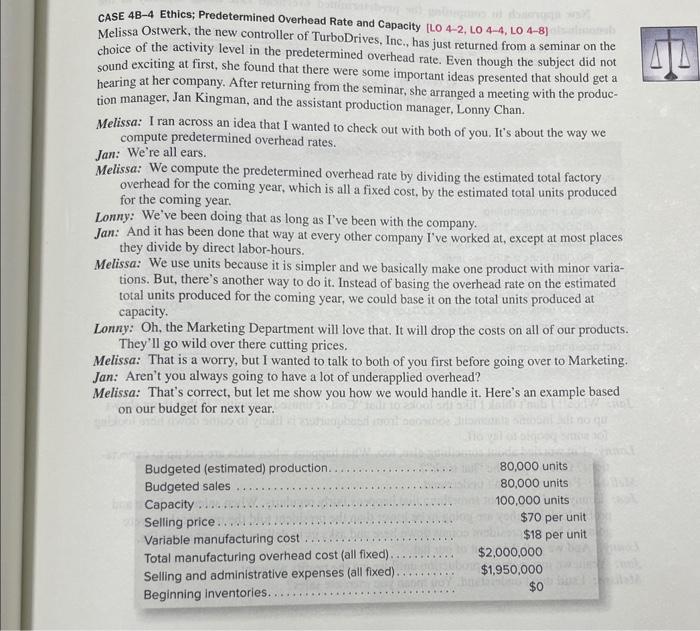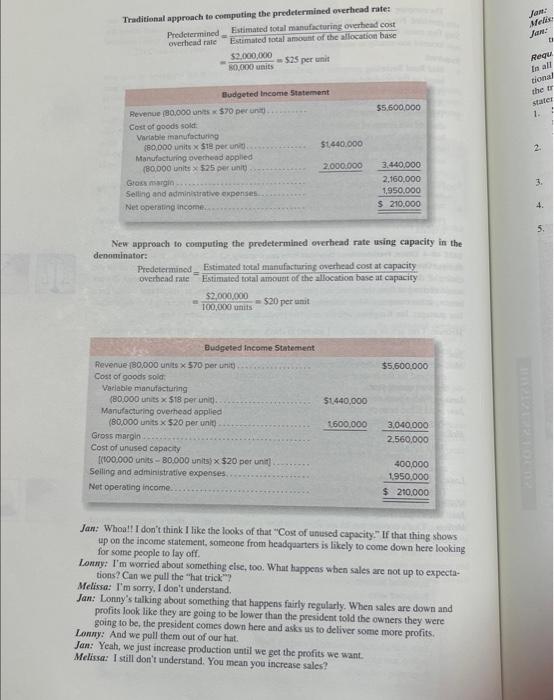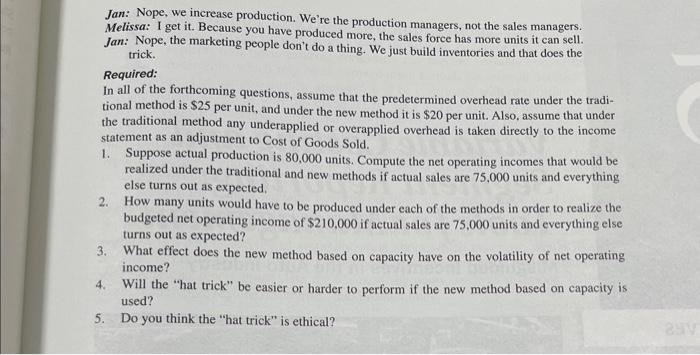CASE 4B-4 Ethics; Predetermined Overhead Rate and Capacity [LO 4-2, LO 4-4, LO 4-8] Melissa Ostwerk, the new controller of TurboDrives, Inc., has just returned from a seminar on the choice of the activity level in the predetermined overhead rate. Even though the subject did not sound exciting at first, she found that there were some important ideas presented that should get a hearing at her company. After returning from the seminar, she arranged a meeting with the production manager, Jan Kingman, and the assistant production manager, Lonny Chan. Melissa: I ran across an idea that I wanted to check out with both of you. It's about the way we compute predetermined overhead rates. Jan: We're all ears. Melissa: We compute the predetermined overhead rate by dividing the estimated total factory overhead for the coming year, which is all a fixed cost, by the estimated total units produced for the coming year. Lonny: We've been doing that as long as Ive been with the company. Jan: And it has been done that way at every other company I've worked at, except at most places they divide by direct labor-hours. Melissa: We use units because it is simpler and we basically make one product with minor variations. But, there's another way to do it. Instead of basing the overhead rate on the estimated total units produced for the coming year, we could base it on the total units produced at capacity. Lonny: Oh, the Marketing Department will love that. It will drop the costs on all of our products. They'll go wild over there cutting prices. Melissa: That is a worry, but I wanted to talk to both of you first before going over to Marketing. Jan: Aren't you always going to have a lot of underapplied overhead? Melissa: That's correct, but let me show you how we would handle it. Here's an example based Traditional approach to coenputing the predetermined everhead rate: PredecrminedoverheadraleEstimatedtotalansountoftheallocationbaseFstimatodtotalmanufacturingovertheadcost=50,000)usits52,000,000=525perunit New approach to computing the predetermined owerhead rate using capacity in the denneinator: =100,000units$2,000,000=$20peranit Jan: Whoa!l I don't think I like the looks of that "Cost of unused capacity" If that thing shows up on the income statenent, someone from headquarters is likely to come down here looking for some people to lay off. Lonny: I'm worried about something else, too. What happens when sales are not up to expectations? Can we pull the "hat trick"? Melissa: I'm sorry. I don't understand. Jan: Lonny"s tallking about something that happens fairly regularly. When sales are down and profits look like they are going to be lower than the president told the owners they were going to be, the peesident comes down here and asks us to deliver some more profits. Lonny: And we pull them out of our hat. Jan: Yeah, we just increase production until we get the profits we want. Melissa: I sill don't understand. You mean you increase sales? Jan: Nope, we increase production. We're the production managers, not the sales managers. Melissa: I get it. Because you have produced more, the sales force has more units it can sell. Jan: Nope, the marketing people don't do a thing. We just build inventories and that does the trick. Required: In all of the forthcoming questions, assume that the predetermined overhead rate under the traditional method is $25 per unit, and under the new method it is $20 per unit. Also, assume that under the traditional method any underapplied or overapplied overhead is taken directly to the income statement as an adjustment to Cost of Goods Sold. 1. Suppose actual production is 80,000 units. Compute the net operating incomes that would be realized under the traditional and new methods if actual sales are 75,000 units and everything else turns out as expected. 2. How many units would have to be produced under each of the methods in order to realize the budgeted net operating income of $210,000 if actual sales are 75,000 units and everything else turns out as expected? 3. What effect does the new method based on capacity have on the volatility of net operating income? 4. Will the "hat trick" be easier or harder to perform if the new method based on capacity is used? 5. Do you think the "hat trick" is ethical









